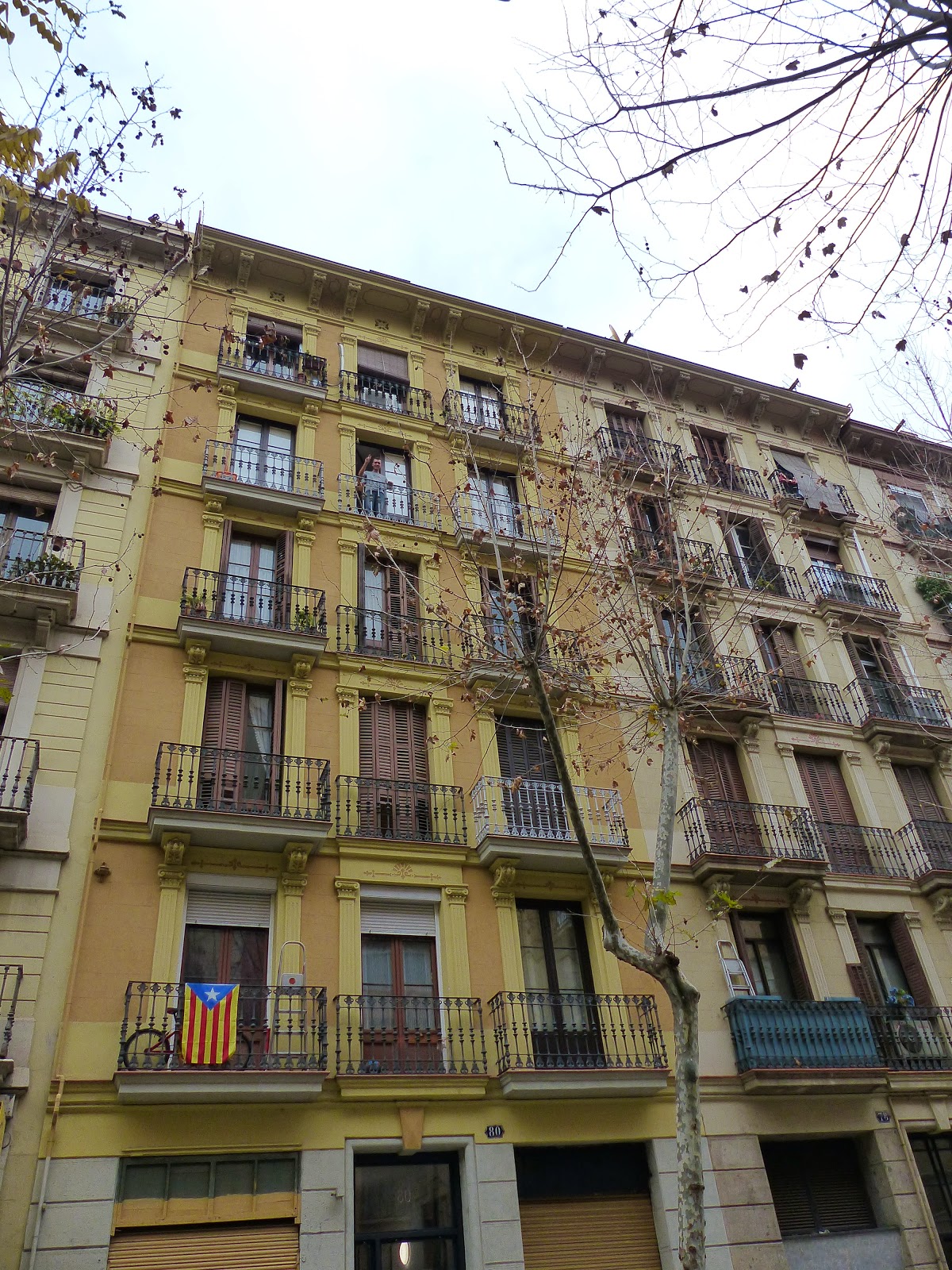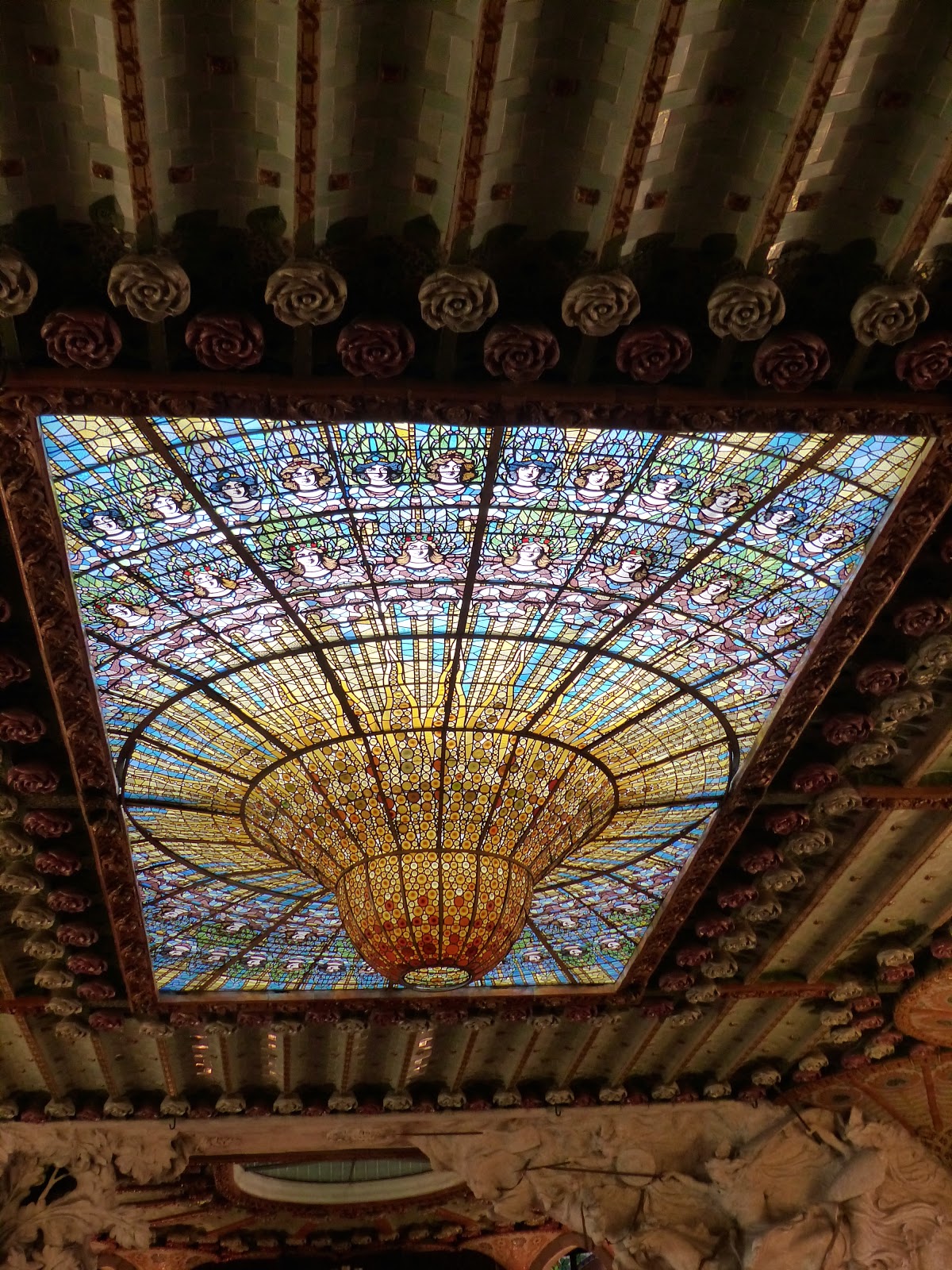I was lucky enough to spend three nights and two days in Barcelona earlier this month - my first trip to Spain.
 |
| our rented flat was in this building |
We rented a flat in the Poblo Sec neighbourhood of the city, and our first trip was to see Barcelona's most famous symbol - the Sagrada Família.
| view of the Sagrada Família |
| outside the Sagrada Família |
As this was January I believe we were lucky as we didn't have to queue to get in - friends who have visited during the summer later told us there was 3 ½ hours of queue!
| Nativity facade |
Sagrada Família is a large Roman Catholic basilica designed by Catalan architect Antoni Gaudí. Construction began in 1882, and Gaudí became involved in 1883, although when he died in 1926 (struck by a tram) the project was less than a quarter complete. Concerning the extremely long construction period, Gaudí is said to have remarked: "My client is not in a hurry." Work was interrupted by the Spanish Civil War in 1936, but has been carried on by various architects since 1940.
 |
| entrance door detail - each insect is different |
Unlike many other places of worship the Sagrada Família, which was consecrated by Pope Benedict in 2010, is filled with light inside. While never intended to be a cathedral (seat of a bishop), from the outset the Sagrada Família was planned to be a cathedral-sized building.
| inside the Sagrada Família |
Construction is expected to be completed by around 2026- 2028.
| inside the Sagrada Família |
There are three facades: Nativity (to the east), Passion (to the West) and Glory (to the South). The latter is yet to be completed.
| sculpture depicting the Kiss of Judas on the Passion facade |
The Plaza Monumental de Barcelona is a former bullring, the last bullfighting arena that was in commercial operation in Catalonia. It was inaugurated in 1914 and expanded in 1916. It was the last place in Catalonia where bullfights were held, since in 2010 the Parliament of Catalonia passed a ban of bullfighting events that came into force in 2012.
| Plaza Monumental (former bullring) |
 |
| Architect-designed telecommunications tower on Sants-Montjuïc |
 |
| Statue of a music hall performer who died 50 years ago, Raquel Meller, still adorned with fresh flowers. |
| colourful Monk parakeets (Myiopsitta monachus) are everywhere |
Palau Güell is a Gaudi-designed mansion built for Catalan tycoon Eusebi Güell between 1886 and 1888.
 |
| part of the facade of Palau Guell |
The next day we started by visiting the Gothic Cathedral of Barcelona, which was constructed between the 13th and 15th centuries.
| interior of Barcelona Cathedral |
The cathedral is next to an interesting part of Barcelona known as the Barri Gòtic or 'Gothic Quarter'. Many of the buildings in the area date from Medieval times, some from as far back as the Roman settlement.
| 'Barcino' was the Roman name for Barcelona |
During the 19th century the city government installed a one-way system for horse-drawn carriages in the narrow streets of the Gothic quarter. Signs said entrada or 'entrance' at one end, and salida ('exit') at the other end, so you were not allowed to enter a street from the end marked salida, only from the entrada end.
| 'entrada' sign on a street in the Old Quarter |
 |
modern sculpture, Plaça Nova square
|
After the Cathedral we headed to the beautiful Palau de la Música Catalana, or Palace of Catalan Music.
 |
| upstairs balcony, Palace of Catalan Music |
This concert hall was designed in the Catalan modernista style by the architect Lluís Domènech i Montaner, and was built between 1905 and 1908 for the Orfeó Català, a choral society.
 |
| stained glass skylight in the concert hall |
The concert hall, which seats about 2,200 people, has been described as one of the most beautiful in the world, and is the only auditorium in Europe that is illuminated during daylight hours entirely by natural light. In a semicircle on the sides of the back of the stage are the figures of 18 young women popularly known as the muses (although there are only nine muses in Greek mythology). The monotone upper bodies of the women protrude from the wall and their lower bodies are depicted by colorful mosaics that form part of the wall. Each of the women is playing a different musical instrument, and each is wearing a different elaborately-designed skirt, blouse, and headdress.
| some of the muses at the back of the stage |
Our final visit was to Park Güell, a park system composed of gardens and architectonic elements designed by Gaudí for Eusebi Güell.
| view from Park Güell |
Entrance to the Park is free but there is a fee to visit the 'monumental precinct' (main entrance and the parts containing mosaics).
| Mosaic salamander (also known as a dragon) designed by Gaudi |
From the entrance a twin flight of steps rises, where the famous salamander or dragon can be found. The most popular image of the park, it is covered with decorative tile-shard mosaic.
| Park Güell at sunset |
There are many other places we could have visited (Picasso Museum, Joan Miro Foundation, La Pedrera etc etc) but time was short, so we had to choose just a few places. We still have plenty more left for another trip!
Suggested reading:
- The Shadow of the Wind by Carlos Ruiz Zafón
You might also like: